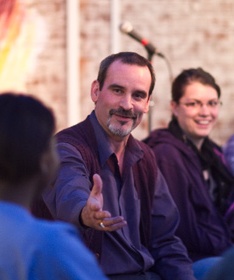
We were stunned to silence as a hushed whisper fell over the meeting hall. Representatives of the “enemy” village had just walked in unexpectedly, interrupting a community peace meeting we were facilitating. Vusi, my South African colleague and I had been toiling for months on a peacebuilding process in Majola, a rural region of the Eastern Cape Province in South Africa, consisting of 32 villages dotting the mountain side. Vusi and I had been invited by community leaders to accompany the Majola region in a quest for peace after the shooting death of two high school girls in January of 2001. These young girls, in school uniform and unarmed were caught in cross-fire while walking to school. This was more than the community could bear and a call to end this decadal violence was sounded.
In the 1960s this “enemy” village started a cycle of violence when they assassinated a chief from another village. In retaliation, the offended village raided the offending village and stole all their cattle (stock-theft). The revenge cycle of stock-theft continued with other villages being drawn in and an increasing number of killings occurring among the cattle thieves on both sides. In December of 1998, after decades of raids and violence, a gun battle broke out in the community leaving 16 persons dead in its wake. The national army was called in to stop the killing and restore “order.”
Back in the meeting hall, Vusi and I quickly regained our composure and after conferring with the local leaders decided to give this disruptive delegation a chance to speak. This village represented the “enemy” from within, conveniently being identified as the “scape-goat” and hoisted with the full responsibility of this destructive conflict and ensuing violence. As the delegated leader started to speak it became clear that we were only going to hear one side of the story. This spokesperson recited a litany of his village’s grievances and how many lives his village had lost, but there was not a mention of the grievances of other communities or responsibility taken for the horrific toll of suffering and death caused by members of his own village. This was a narrative of chosen trauma – a constructed script of perpetrator as victim. Those who were present grew restless and agitated as they were forced to listen to this lopsided version of history. The anxiety in the room was rising and ‘common sense’ would have required us to intervene and bring this distorted monologue to a close.
However, the Spirit nudged us otherwise. Defying all logic, Vusi and I, in consultation with the local leaders decided to invite the speaker to continue until he had vented all he wanted to say. We implored those in attendance to listen and promised them the opportunity to ask questions at the end. The speaker continued on for what felt like endlessly, but eventually the floor was opened for questions. Those in attendance began asking carefully crafted and probing questions of clarification. Emotions were high and clearly close to the surface and what transpired was a painful, but healthy dialogue giving voice to the many shades of past truth held dear to all the communities present. We closed with a challenge to the hope of reconciliation and the meeting was adjourned.
Vusi and I left the meeting discouraged. We wondered what we had accomplished if anything at all. Here we had given the “enemy” the floor to vent and they never acknowledged responsibility, expressed remorse or offered an apology. To add injury to insult, the listening communities were implored to bear this twisted testimony of an unrepentant perpetrator without having any opportunity to voice their own story of pain. This was backward – this was not how we planned it.
A few weeks later, the surprising news came. The community leaders went to visit this offending village and were received with a warm welcome, and open arms. They were invited to eat together and the offending village elders put forward five persons from their midst to serve as a mediation team. Each village was to choose a five-person mediation team that would be trained in the next phase of our intervention plan. Amazingly, this “enemy” village was the first to choose their mediation team!
What happened here? It seems that in the act of deep listening, a serendipitous transformation occurred. As the proclaimed “enemy” was given audience and a public voice their humanity was reconstructed. Some innermost need for recognition and dignity was satisfied and in that catalytic moment trust was restored – so much so that the formally marginalized were integrated into the whole.
 [Carl Stauffer – PhD, MA ’02 – is Assistant Professor of Development and Justice Studies at EMU’s Center for Justice and Peacebuilding. This piece originally appeared in the Caux Communique, January 18, 2012.]
[Carl Stauffer – PhD, MA ’02 – is Assistant Professor of Development and Justice Studies at EMU’s Center for Justice and Peacebuilding. This piece originally appeared in the Caux Communique, January 18, 2012.]

What a wonderful, instructive story. Thank you, Carl, for sharing!
Amazing.
Thank you for sharing this inspirational story. What a wonderful reminder of the power of listening!
It just happens that I am teaching a course on conflict resolution tomorrow and will share this with participants – what a gift to help bring what seems like a simple, basic skill to full life!
When people are marginalized, they must struggle to have their voice be heard. Giving them the opportunity was a gift for everyone…even if the value was not recognized while it was presented.